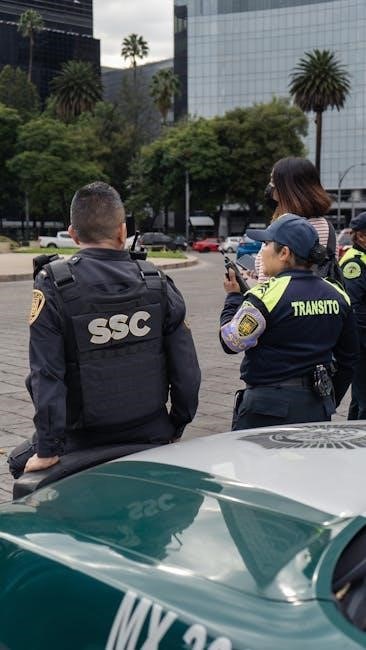Manual traffic signals are vital tools operated by traffic agents to maintain order, safety, and efficiency in road environments. They ensure smooth vehicle and pedestrian movement, reducing accidents and congestion while promoting legal compliance and urban mobility.

Definition and Purpose of Manual Traffic Signals
Manual traffic signals are non-automatic tools used by traffic agents to regulate and direct road users, ensuring safe and orderly movement; These signals include hand gestures, whistles, and physical barriers. Their primary purpose is to communicate clear instructions to drivers and pedestrians, preventing accidents and maintaining efficient traffic flow. They are particularly effective in unexpected situations or when electronic systems fail. By providing immediate guidance, manual signals help enforce traffic rules, reduce congestion, and protect vulnerable road users. Their visibility and clarity are essential for effective communication, making them a cornerstone of urban mobility and safety management. They adapt to dynamic conditions, ensuring compliance with legal obligations and enhancing overall road safety.
Types of Manual Traffic Signals
Manual traffic signals include hand gestures, whistle signals, and physical barriers, each playing a crucial role in directing traffic flow and ensuring safety on the roads.
Hand Gestures Used by Traffic Agents
Hand gestures are essential tools for traffic agents to communicate clearly and effectively. Agents use specific movements to direct drivers and pedestrians, ensuring safe and orderly traffic flow. Common gestures include extending the arm to halt traffic, pointing to indicate direction, and raising the palm to signal stopping. These visual cues are universally understood, making them vital in noisy or chaotic environments. Proper hand signals help prevent accidents by providing clear instructions. Their effectiveness relies on consistency and visibility, ensuring all road users comprehend the agent’s directions without confusion. Hand gestures remain a cornerstone of manual traffic control, enhancing safety and efficiency in urban areas.
Whistle Signals and Their Meanings
Whistle signals are a critical component of manual traffic control, used by agents to convey clear instructions to drivers and pedestrians. A single whistle blast typically indicates “stop,” while two blasts signal “go.” Three short bursts may signify an emergency or special instruction. These auditory cues are especially effective in noisy environments where visual signals might be missed. Consistency in whistle patterns is essential to avoid confusion and ensure universal understanding. By combining whistle signals with hand gestures, traffic agents maintain order and safety in busy intersections. Their effective use enhances communication, reduces accidents, and ensures smooth traffic flow, making them indispensable in urban mobility management.
Physical Barriers and Their Role in Traffic Control
Physical barriers, such as manual barricades or traffic cones, play a crucial role in traffic management by providing clear, visible separation and direction for vehicles and pedestrians. These barriers are often used in conjunction with whistle and hand signals to enforce traffic rules effectively. For instance, manual barriers like barrera o talanquera manual cierre lento are designed to block or redirect traffic flow safely. They are particularly useful in emergency situations or construction zones, where temporary control is necessary. By creating a physical divide, these barriers ensure compliance with traffic signals and prevent unauthorized access to restricted areas, enhancing overall safety and order in urban environments. Their durability and visibility make them indispensable in high-traffic scenarios.
Categories of Traffic Signs
Manual traffic signals are categorized into preventive, restrictive, and regulatory signs, each serving distinct purposes to ensure safety, order, and legal compliance in urban and rural areas.
Preventive Signals: Warning of Potential Hazards
Preventive signals are designed to alert drivers and pedestrians about potential hazards ahead, such as sharp curves, pedestrian crossings, or roadwork. These signals are crucial for maintaining safety and reducing accidents. By providing early warnings, they allow road users to adjust their speed or direction accordingly. Common examples include signs indicating speed bumps, intersections, or merging traffic. Their clear and standardized designs ensure visibility and quick comprehension. Disregarding these signals can lead to dangerous situations, emphasizing their importance in urban and rural areas. Regular maintenance of these signals is essential to ensure they remain effective in preventing accidents and promoting smooth traffic flow.
Restrictive Signals: Limiting Certain Actions
Restrictive signals are designed to limit certain actions or behaviors on the road, ensuring better traffic management and safety. These signals often specify maximum or minimum speeds, prohibit certain maneuvers like U-turns, or restrict access to specific vehicle types. For example, weight restrictions on bridges or lanes designated for public transport only. Their purpose is to organize traffic flow efficiently and minimize potential risks. By clearly indicating what is not allowed, these signals help drivers make informed decisions, reducing chaos and accidents. Compliance with restrictive signals is essential for maintaining order and safety on the roads, benefiting all users equally. Their proper enforcement is key to their effectiveness in urban and rural settings alike.
Regulatory Signals: Mandatory Compliance
Regulatory signals are enforceable rules that drivers and pedestrians must follow to ensure safe and orderly traffic flow. These signals are legally binding and include signs like “Stop,” “No U-Turn,” and “Speed Limit.” Their purpose is to establish clear guidelines for road users, preventing accidents and maintaining order. Compliance with regulatory signals is mandatory, and violations can result in legal penalties. Examples include prohibitions on entering certain lanes or restrictions on specific vehicle types. These signals are critical for protecting all road users, from drivers and cyclists to pedestrians. By adhering to regulatory signals, everyone contributes to a safer and more efficient transportation system. Their strict enforcement ensures accountability and reduces risks for all. Regulatory signals are fundamental to modern traffic management systems worldwide.

Importance of Manual Traffic Signals
Manual traffic signals are crucial for preventing accidents, ensuring safety, and improving traffic flow. They enforce legal obligations, promoting a secure and organized road environment for all users.
Preventing Accidents and Ensuring Safety
Manual traffic signals play a critical role in preventing accidents by providing clear and immediate instructions to drivers and pedestrians. Traffic agents use hand gestures, whistles, and barriers to control movements effectively, reducing potential hazards. Clear signaling helps avoid collisions, especially in areas with high pedestrian activity or construction zones. By ensuring adherence to traffic rules, these signals minimize risks and create a safer environment for all road users. Their visibility and consistency are essential in maintaining order and preventing misunderstandings that could lead to accidents. Regular training of traffic agents further enhances the effectiveness of these manual signals in ensuring safety.
Improving Traffic Flow and Reducing Congestion
Manual traffic signals are essential for optimizing traffic flow and minimizing congestion in busy urban areas. By providing clear, real-time instructions, traffic agents help drivers and pedestrians navigate intersections smoothly, reducing delays. These signals are particularly effective during peak hours or when automated systems fail. Their ability to adapt to dynamic situations ensures efficient movement, preventing bottlenecks and promoting a steady pace of traffic. This proactive management not only reduces congestion but also lowers the frustration associated with stop-and-go traffic, creating a more organized and fluid transportation network. Effective manual signaling is crucial for maintaining urban mobility and ensuring roads remain operational at maximum capacity.
Legal Obligations and Enforcement
Manual traffic signals play a crucial role in enforcing legal obligations and ensuring compliance with traffic laws. Drivers and pedestrians are required to adhere to these signals, as they are essential for maintaining order and safety on the roads. Failure to comply with manual traffic signals can result in fines or penalties, as specified by local traffic regulations. Traffic agents are legally empowered to direct and control traffic flow, and their instructions must be followed without exception. This legal framework ensures accountability and promotes a culture of adherence to traffic rules. By integrating manual signals with technological systems, authorities can enhance enforcement and maintain a high standard of road safety and discipline.

Challenges in Implementing Manual Traffic Signals
Challenges include vandalism of traffic signs, disobedience by drivers and pedestrians, and the need for consistent enforcement to ensure safety and efficiency in traffic management systems.
Disobedience of Traffic Rules by Drivers and Pedestrians
Disobedience of traffic rules poses significant challenges, as drivers and pedestrians often ignore manual signals, leading to increased risks of accidents and chaos. This non-compliance stems from a lack of awareness or disregard for safety measures, complicating the efforts of traffic agents.
Such behavior undermines the effectiveness of manual traffic signals, creating unsafe conditions for all road users. Addressing this issue requires stricter enforcement, public awareness campaigns, and education to ensure adherence to traffic regulations and promote a culture of road safety.
Vandalism and Destruction of Traffic Signs
Vandalism and destruction of traffic signs are significant challenges, as these actions compromise road safety and disrupt traffic flow. Many signs are intentionally damaged, stolen, or defaced, reducing their visibility and effectiveness.
This issue not only increases the risk of accidents but also burdens authorities with costly repairs and replacements. Public awareness campaigns are essential to address this problem, emphasizing the importance of preserving traffic infrastructure for everyone’s safety. Without intact signs, manual traffic signals lose their impact, leading to chaos and potential hazards for drivers and pedestrians alike.

New Developments in Manual Traffic Signals
Modern advancements include integrating technology, such as smart sensors and real-time data, to enhance traffic signal efficiency and safety, while training programs improve traffic agents’ effectiveness.
Integration of Technology for Enhanced Safety
Modern technology is revolutionizing manual traffic signals by enhancing safety and efficiency. Smart sensors and real-time data systems are being integrated to optimize traffic flow and reduce accidents. These innovations enable traffic agents to monitor high-traffic areas remotely and respond swiftly to emergencies. Additionally, new signaling devices equipped with LED lights and audible alerts improve visibility for all road users, including those with visual impairments. Recent developments in Colombia include the introduction of smart traffic signs designed to reduce motorcycle-related incidents, ensuring better protection for vulnerable road users. These advancements align with updated manuals on traffic signal design, emphasizing clarity and visibility to foster safer urban mobility.
Training Programs for Traffic Agents
Training programs for traffic agents are essential to ensure effective use of manual traffic signals. These programs focus on teaching agents how to use hand gestures, whistle commands, and physical barriers to manage traffic flow safely. Agents learn to interpret and implement traffic rules accurately, ensuring compliance with legal standards. In Colombia, updated training initiatives emphasize the integration of new traffic signs aimed at reducing motorcycle-related incidents. These programs also cover the proper use of advanced signaling devices, such as LED-equipped signs, to enhance visibility and safety. By equipping agents with the necessary skills and knowledge, these training programs contribute to fewer accidents and smoother traffic management, fostering a safer urban environment for all road users.
Manual traffic signals are indispensable for ensuring road safety, efficiency, and legal compliance, fostering a responsible and organized transportation system for all users.
The Role of Manual Traffic Signals in Modern Transportation Systems
Manual traffic signals play a crucial role in modern transportation systems by ensuring safety, efficiency, and legal compliance. They are essential for managing traffic flow, preventing accidents, and guiding both drivers and pedestrians. These signals, including hand gestures, whistles, and physical barriers, provide clear instructions that help maintain order on the roads. By adhering to these signals, road users contribute to a smoother and more organized traffic environment. Their effectiveness is further enhanced by the integration of technology and comprehensive training programs for traffic agents. As a result, manual traffic signals remain a cornerstone of urban mobility, fostering a responsible and coordinated transportation network.